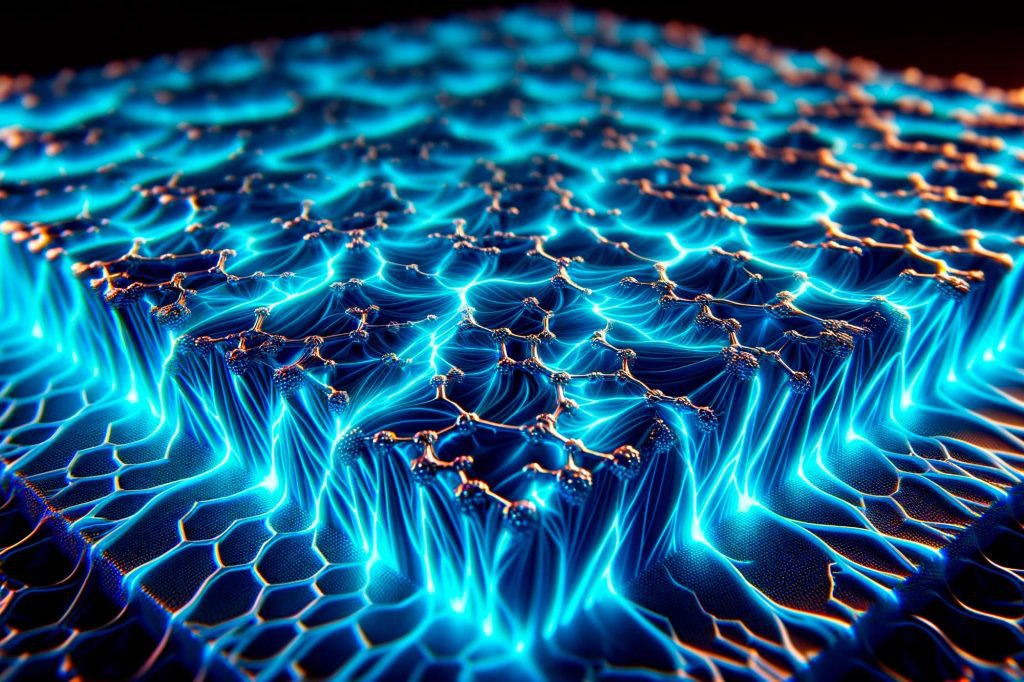
Researchers have created a ferroelectric capacitor that has 19 times more energy density than current models and with over 90% efficiency. They achieved this by using innovative 2D/3D/2D heterostructures. Credit: SciTechDaily.com
Scientists have come up with a new way to manage the relaxation time of ferroelectric capacitors using 2D materials. This significantly improves their ability to store energy. This advancement results in a structure that enhances energy density and efficiency, offering promise for high-power electronics and sustainable technologies.
Electrostatic capacitors are vital in modern electronics. They allow for extremely fast charging and discharging, providing energy storage and power for a range of devices from smartphones and laptops to medical devices and industrial equipment. However, the ferroelectric materials used in capacitors lose a significant amount of energy due to their properties, making high energy storage challenging.
Innovations in Ferroelectric Capacitors
Sang-Hoon Bae, who is an assistant professor of mechanical engineering and materials science at Washington University in St. Louis, has tackled this long-standing challenge in using ferroelectric materials for energy storage.
In a study published today (April 18) in the journal Science, Bae and his team, including Rohan Mishra, an associate professor of mechanical engineering and materials science, and Chuan Wang, an associate professor of electrical and systems engineering, both at WashU, and Frances Ross, the TDK Professor in Materials Science and Engineering at MIT, introduced an approach to control the relaxation time of ferroelectric capacitors using 2D materials.
Developing Unique Heterostructures
In collaboration with Bae, doctoral student Justin S. Kim and postdoctoral researcher Sangmoon Han created unique 2D/3D/2D heterostructures. These structures minimize energy loss while maintaining the beneficial material properties of ferroelectric 3D materials.
Their method involves cleverly layering 2D and 3D materials in extremely thin layers with carefully designed chemical and nonchemical bonds between each layer. A very thin 3D core is placed between two outer 2D layers to create a stack that is only about 30 nanometers thick. That’s about one-tenth the size of an average virus particle.
Breakthrough in Energy Storage
“We developed a new structure based on the innovations we’ve already made in my lab involving 2D materials,” Bae said. “Initially, we weren’t focused on energy storage, but during our exploration of material properties, we found a new physical phenomenon that we realized could be applied to energy storage, and that was both very interesting and potentially much more useful.”
The 2D/3D/2D heterostructures are carefully crafted to exist in the sweet spot between conductivity and nonconductivity, where semiconducting materials have optimal electric properties for energy storage. With this design, Bae and his team reported an energy density up to 19 times higher than commercially available ferroelectric capacitors, and they achieved an efficiency of over 90%, which is also unprecedented.
Effect on Future Electronics
“We discovered that the time it takes for the dielectric material to relax can be changed or triggered by a very small gap in the material's structure,” Bae said. “This new physical phenomenon is something we hadn't observed before. It allows us to control the dielectric material in a way that prevents it from becoming polarized and losing its ability to hold charge.”
As the world deals with the importance of shifting toward next-generation electronics components, Bae’s innovative heterostructure material opens the door for high-performance electronic devices, including high-power electronics, high-frequency wireless communication systems, and integrated circuit chips. These advancements are particularly important in fields that need strong power management solutions, like electric vehicles and infrastructure development.
Future Goals and Uses
“Fundamentally, this structure we've created is a new electronic material,” Bae stated. “We're not yet at 100% efficiency, but we're already surpassing what other labs are achieving. Our next steps will be to improve this material structure even more so that we can fulfill the demand for extremely fast charging and discharging and very high energy densities in capacitors. We need to achieve that without losing storage capacity after repeated charges in order for this material to be widely used in large electronics, such as electric vehicles, and other emerging green technologies.”
Reference: “High energy density in artificial heterostructures through relaxation time modulation” April 18, 2024, Science.
DOI: 10.1126/science.adl2835
Han S, Kim JS, Park E, Meng Y, Xu Z, Foucher AC, Jung GY, Roh I, Lee S, Kim SO, Moon JY, Kim SI, Bae S, Zhang X, Park BI, Seo S, Li Y, Shin H, Reidy K, Hoang AT, Sundaram S, Vuong P, Kim C, Zhao J, Hwang J, Wang C, Choi H, Kim DH, Kwon J, Park JH, Ougazzaden A, Lee JH, Ahn JH, Kim J, Mishra R, Kim HS, Ross FM, and Bae SH. High energy density in artificial heterostructures through relaxation time modulation. Science, April 18, 2024. DOI: X
This research received support from the National Science Foundation (2240995, DMR-2122070 and DMR-2145797), Samsung Electronics Co., Ltd. (IO221219-04250-01), the Korea Institute for Advancement of Technology (P0017305), the National Research Foundation of Korea (2015R1A3A2066337), and the Army Research Office’s Multidisciplinary University Research Initiative (W911NF-21-1-0327). Computational resources were provided through allocation DMR160007 from the Advanced Cyberinfrastructure Coordination Ecosystem: Services & Support (ACCESS) program, which is supported by NSF.



